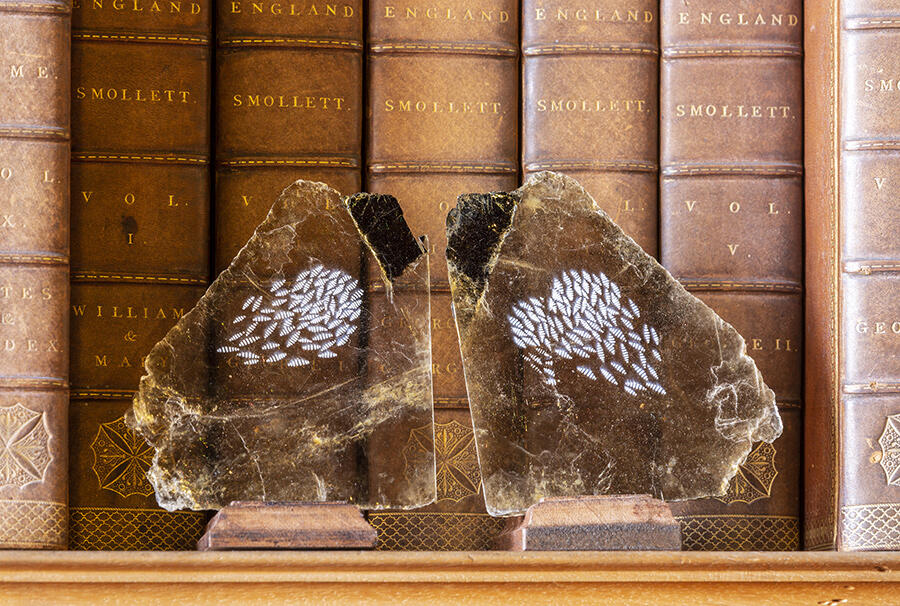Ilana Halperin Sets House (and Geological Histories) In Order
On the Isle of Bute, the artist uses objects to expose the geology of the 18th-century Mount Stuart House and engage with the Scottish mansion's material history
On the Isle of Bute, the artist uses objects to expose the geology of the 18th-century Mount Stuart House and engage with the Scottish mansion's material history

Artist, lithophile and volcano lover Ilana Halperin reminds us that rock is not always rock-steady, and that human and geological time are entwined, not irreconcilable. Many collaborations furnish her exhibition ‘There Is a Volcano Behind My House’, not all of them with human entities.

The Rock Cycle (2021) – a cluster of bony objects arranged in the crypt of Mount Stuart House on the Isle of Bute – are newly formed stones. Beachcombed shards of ceramic tile and brick once made on Bute were sent to the Fontaines Pétrifiantes de Saint Nectaire, where they were calcified by subterranean streams delivering a rapid accretion of limestone in a process similar to the formation of stalagmites. The new stones are a European hybrid – Scottish clay and French limestone. Halperin has polished sections so they’re worn and smooth as if rubbed like a talisman.
Mount Stuart House is also a geological hybrid, albeit a totem of the anthropocene, capitalocene, plantationocene – or however we’re currently identifying this violently human-influenced geological era. Built with vast wealth over generations, the exterior is local red sandstone, but the great hall and chapel are clad in marble shipped from Sicily. Sheets of mica create a mirrored ceiling behind interlaced coats of arms in the drawing room. Quartz crystals set in the blue dome above the great hall describe the constellations of the zodiac.

Halperin, too, is a transplanted entity. A New Yorker whose forebears fled the pogroms, she now lives in Scotland. There really is a small, extinct volcano – Suidhe – behind her home on Bute. Suidhe is the physical departure point for Field Studies (from Kilchattan Bay to Hawk’s Neb) (2019), watercolours capturing the rhythm of the walked landscape. The colours are unexpected – hot yellow of gorse blooms, rosy pink from the sand of Kilchattan Bay, indigo shadows of columnar sandstone – the landscape observed through the conventions of geology rather than of art history. The studies hang in a dense cluster, like a handful of pebbles, in the upper gallery of the great hall.
In the drawing room, one of these watercolours is reimagined as a knitted panel, thrown over an ottoman as though an heirloom of the Earls of Bute. Our Hands Enact the Geologic Process, Part Two (2020) was knitted by Syrian women in Istanbul. It knots together diverse histories: one, of Halperin’s mother, who designed knitwear, filling her home with women friends looping wool along needle; another, of the two dozen refugee families from Syria who started a new life on Bute in 2015.

In Excerpts from the Library (2021) – an artist audiobook released online as part of Glasgow International – Halperin explores her feelings for various volcanoes, as well as certain human and geological relationships. She charts her mother’s degenerative dementia along the timescale of the melting Lyell Glacier in Yosemite National Park. In the watercolour paintings My Conglomerate Family I, II, III (2019), she imagines a new template for the family as a compound of diverse elements, bonded together like sedimentary rock.
Along library shelves, Halperin has placed polished and engraved pieces of mica found in New England and the Scottish Highlands. Like so many of her subtle interventions, they might almost be treasures from the family collection. Because they can be separated into thin leaves, mica specimens are known as ‘books’. Halperin proposes a different kind of library, one which offers knowledge at a timescale so vast that constructs appropriate even to multiple generations of human life – like nationhood or property – make no sense. Stone migrates at its own speed, tying place to place. The mica that glitters from the ceiling of Mount Stuart House also sparkles from the streets of New York.
'Ilana Halperin: There is a Volcano Behind My House' is on view at Mount Stuart House, Isle of Bute, through 15 August 2021.
Main image: Ilana Halperin, The Rock Cycle, 2021, exhibition view. Courtesy: the artist and Patricia Fleming Gallery, Glasgow; photograph: Keith Hunter























